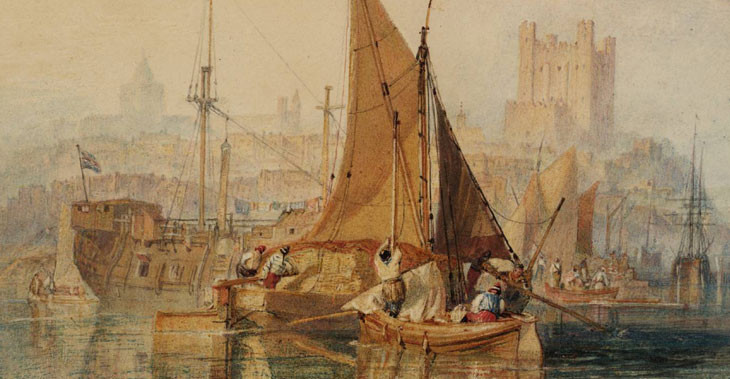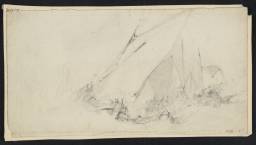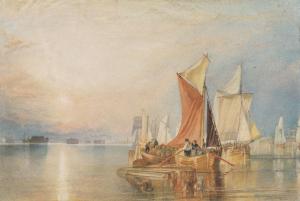‘Rivers of England’ Watercolours and Related Works c.1822–4
From the entry
The Rivers of England is a topographical watercolour and mezzotint engraving series initiated by the engraver and publisher William Bernard Cooke (1778–1855). Between 1822 and 1826 Cooke commissioned Turner to produce eighteen designs depicting the rivers and canals of England in picturesque settings. Averaging a diminutive one hundred and fifty-five by two hundred and twenty millimetres, the drawings were all executed on white wove watercolour paper sized with gelatine. The size made for a relatively non-absorbent support allowing the drawings to be heavily worked. As a result, the Rivers watercolours are characterised by a sharpness of definition, a brilliance of colouring, and an intricacy of detail. Perhaps because of their delicacy, then, Turner lent rather than sold the drawings to Cooke for engraving, the price being set at eight guineas for each design. Turner had previously collaborated with Cooke on Views in Sussex (1816–20) and continued to work with the publisher on a number of ...
D17762–D17765, D18134–D18141, D18144–D18149, D18151, D18155–D18156
Turner Bequest Turner Bequest CCIII E–H, CCVIII A–H, K, L–R, V, W
Turner Bequest Turner Bequest CCIII E–H, CCVIII A–H, K, L–R, V, W
References
The Rivers of England is a topographical watercolour and mezzotint engraving series initiated by the engraver and publisher William Bernard Cooke (1778–1855). Between 1822 and 1826 Cooke commissioned Turner to produce eighteen designs depicting the rivers and canals of England in picturesque settings.1 Averaging a diminutive one hundred and fifty-five by two hundred and twenty millimetres, the drawings were all executed on white wove watercolour paper sized with gelatine. The size made for a relatively non-absorbent support allowing the drawings to be heavily worked. As a result, the Rivers watercolours are characterised by a sharpness of definition, a brilliance of colouring, and an intricacy of detail. Perhaps because of their delicacy, then, Turner lent rather than sold the drawings to Cooke for engraving, the price being set at eight guineas for each design.2
Turner had previously collaborated with Cooke on Views in Sussex (1816–20) and continued to work with the publisher on a number of other engraving projects simultaneously to the Rivers of England. These include: the Picturesque Views of the Southern Coast of England (1814–26), and the Rivers of Devon (1815–23). Four of the six engravers employed by Cooke to produce the Rivers plates also had previously worked with Turner: Thomas Goff Lupton, Charles Turner, William Say, and Samuel William Reynolds who had collaborated with the artist on the Liber Studiorum project.3
A principal impetus for the Rivers series was Cooke’s desire to capitalise on the newly developed technology of steel-faced mezzotint engraving, developed by Thomas Goff Lupton in 1820.4 As Lupton discovered, a steel-faced mezzotint plate was more durable than the traditional copper-faced, enabling a greater number of impressions to be taken from one engraved plate without the design wearing down.5 The prints, then, could be produced more efficiently and for less money, securing Cooke a larger number of potential customers.
The Rivers of England, in its original incarnation, was intended to comprise thirty-six plates, published in twelve parts of three prints each.6 Of the twenty-one prints published, however, only sixteen were after Turner’s drawings. His view of Arundel Castle was never finished and The Medway was not engraved.7 Four subjects were after Turner’s late friend Thomas Girtin (1775–1802): York Minster, Kirkstall Abbey, Ripon Minster, and Bolton Abbey and one, Eton on Thames, was after Turner’s contemporary, the artist William Collins (1788–1847). Girtin’s Ripon, Collins’s Eton, and Turner’s Totnes were cancelled, however, owing, as the advertisement states, to ‘imperfections in the manufacture of the steel plates on which they have been engraved’.8
In the last months of 1826 Turner’s involvement in the Rivers project terminated. His relations with Cooke had soured quite considerably, in part as a result of Turner’s tendency, according to art historian Barry Venny, to be an ‘aggressive negotiator’ who knew ‘that his name on the prospectus greatly enhanced a publication’s chances of success’.9 This factor, coupled with the demands of engraving and publishing timetables and the effects of an economic decline affecting the printing industry in the mid-1820s, contributed to the collapse of the collaboration.10 As a result of this fracture, Cooke decided to bind together all of the impressions including the unsold or cancelled prints and later republished them under the title The River Scenery of England in 1827.11
As the title describes, the Rivers watercolours depict English inland waterways, estuaries, and mouths of rivers. The subjects were chosen to offer, as W.B. Cooke puffed, ‘a series of picturesque delineations of the Interior of the Country’ as companion pieces to the Southern Coast of England series which displayed ‘the most prominent features of its shores’.12 Turner’s Rivers of England drawings, then, are a celebration of Britain’s fluvial networks and their importance to the human landscape: to local life and labour and to the nation’s economy as a whole.
River and canal systems in the nineteenth century represented arteries of commerce and communication and played a key role in the preservation of the kingdom’s national and trading boundaries. Indeed, in a number of the Rivers drawings local trade is depicted as either being contingent on or at least aided by a waterway. See, for example, the collier brigs transporting coal in the depictions of Newcastle and Shields on the River Tyne (Tate D18144, D18155; Turner Bequest CCVIII K, V); the barges carrying logs and cargo at Stangate Creek, on the River Medway (Tate D18134; Turner Bequest CCVIII A); or the freight vessels lining up at Kirkstall Lock to navigate the Leeds-Liverpool Canal (Tate D18145; Turner Bequest CCVIII L). Turner also includes small but significant references to the forms of transport set to supersede the rivers as the dominant communication links: roads with carriages, for example, or rudimentary rail networks for the transportation of coal.
A motif found in an number of the drawings is patriotic imagery: the union jack flag suspended on a hulk in the view of Rochester for example (Tate D18156, Turner Bequest CCVIII W); the inclusion of members of the armed forces such as the sailor waving to a naval brig at the banks of the Dart (Tate D18137; Turner Bequest CCVIII D); or the uniformed marine in the view of Newcastle. These are tokens to remind the viewer of England’s military and colonial identity; the memory of the Napoleonic Wars (1803–15), after all, was still relatively fresh in the public consciousness at the time these designs were produced.
The picturesqueness of the British landscape and the historical monuments within her counties is also an underlying theme of the Rivers series. The ruined medieval castles of Norham (Tate D18148; Turner Bequest CCVIII O), Okehampton (Tate D18138; Turner Bequest CCVIII E), Brougham (Tate D18147; Turner Bequest CCVIII N) and the ancient Cistercian abbey at Kirkstall (Tate D18146; Turner Bequest CCVIII M) all offered the viewer rich historical, antiquarian, and literary associations.
One county in particular appears to have appealed to Turner in the Rivers series for its ability to encompass all these themes. Devonshire’s rivers Dart and Okement formed the basis of four watercolours in the series (Tate D18135–D18138; Turner Bequest CCVIII B, C, D, E), perhaps, as the nineteenth-century antiquaries John Britton and Edward Brayley write, because ‘there is not...a single county in the British Islands more replete with picturesque and romantic features, antiquarian remains, geological riches, and... maritime relations’ than Devonshire.13 The county is represented in this series, as the art historian Andrew Kennedy writes, ‘as encapsulating national identity in a particularly reassuring way, which encompasses both the modern (especially naval power) and “unchanging” features (wooded scenery and antiquities)’.14
The impression of the elements and the transitory effects of weather systems also feature heavily in the Rivers designs. The climatic conditions in the view of Arundel (Tate D18140; Turner Bequest CCVIII H) and More Park (Tate D18141; Turner Bequest CCVIII G) are palpable, Turner conveying a sense of the dampness after rainfall and the way in which beams of sunlight pierce through rain-heavy cloud. Indeed it was this aspect of the Rivers works which the art critic and writer Theodore Cook particularly enjoyed: the ‘abiding and constant thread of... interest’ in these works, he writes, is ‘Turner’s delight in the forms of water, and in the beauties of the air, atmosphere, and growth near water’.15
This strong sense of atmospheric effect is in large part due to Turner’s employment of a particular colouring technique, one which achieved a richness and complexity of tone and texture. The drawings’ ‘jewel-like...intensity of colour and sharp detailing’, as Eric Shanes writes, was realised through the use of the stippling method: the meticulous application of pigment through very fine dots and hatching.16 Turner’s processes of making here ‘run the gamut’, the art historian John Gage writes, ‘from the first laying-in of generous fields of colour to their development by delicate hatching and stippling with brilliant colour using fine, single-haired brushes, like a miniaturist or even a jeweller setting his gems’.17 The technique enabled the artist to attain ‘infinite gradations of tone and texture’ and hence produce ‘optical...more luminous colour-mixtures’.18
Turner’s technique in the Rivers designs, however, was more complex than a simple overlaying of coloured stipples and hatchings. The view of Norham Castle (Tate D18136l Turner Bequest CCVIII C), for example, is thought to be one of the first pictures where Turner applied pigments ‘prismatically’: where the primary colours of red, yellow and blue are ‘superimposed one onto another to produce three secondaries, orange, purple and green’.19 This system of colouring is believed to have been informed by the colour and light theories of the Scottish physicist Sir David Brewster (1781–1868) whom Turner met during an 1818 trip to Edinburgh.20 The effect of this ‘prismatic’ application of pigment is a spectral and chromatic richness which, coupled with the diminutive size of the drawings, lends the Rivers of England watercolours a truly ‘gem-like’ appeal.21
The original Rivers of England watercolours acquired through the Turner Bequest in 1856 are: Shields, on the River Tyne; Newcastle-on-Tyne, More Park, near Watford, on the River Colne; Rochester, on the River Medway; Norham Castle, on the River Tweed; Dartmouth Castle, on the River Dart; Dartmouth, on the River Dart, Okehampton Castle, on the River Okement; Brougham Castle, near the Junction of the Rivers Eamont and Lowther; Kirkstall Abbey, on the River Aire; Kirkstall Lock, on the River Aire; Mouth of the River Humber; Arundel Castle, on the River Arun; Arundel Castle, with Rainbow; Stangate Creek, on the River Medway; Totnes, on the River Dart; and finally The Medway. One other watercolour entitled Warkworth Castle on the Coquet belongs to this series according to Turner scholar Andrew Wilton, however the size, provenance, and whereabouts of this work are unknown.22
Little preparatory material in the form of pencil or colour sketches and studies exists for the Rivers watercolours. Alexander Finberg did identify three finely wrought pencil sketches of shipping however, which are believed to have been taken on the same sheet and later separated (Tate D17762 – D17765; Turner Bequest CCIII E–H). Finberg associated the sketches with the view of the Mouth of the River Humber (Tate D18151; Turner Bequest CCVIII R).23
Turner went on to collaborate with the engraver Thomas Lupton on a watercolour and mezzotint engraving scheme to accompany the Rivers series in 1825. Entitled The Ports of England, these designs have much in common in terms of size, scale, and execution with this scheme (see Tate D18142 – D18143, D18150–D18154; Turner Bequest CCVIII I, J, Q, S, T, U).
Gillian Forrester, ‘Lupton, Thomas Goff (1791–1873)’, Oxford Dictionary of National Biography, Oxford University Press, 2004 http://www.oxforddnb.com.ezproxy.londonlibrary.co.uk/view/article/17205 Accessed 14 Feb 2013.
Advertisement bound in a copy of the seventh issue, private collection quoted in Lyle and Perkins 1989, p.52.
How to cite
Alice Rylance-Watson, ‘‘Rivers of England’ Watercolours and Related Works c.1822–4’, March 2013, in David Blayney Brown (ed.), J.M.W. Turner: Sketchbooks, Drawings and Watercolours, Tate Research Publication, August 2014, https://www



